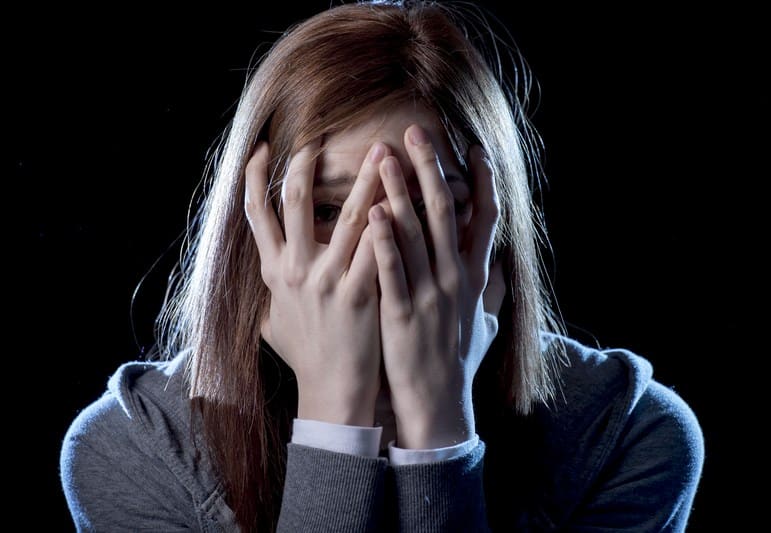Introduction

Anxiety disorders include disorders that share features of excessive fear and anxiety and related behavioural disturbances.
Fear is the emotional response to real or perceived imminent threat, whereas anxiety is anticipation of future threat. Obviously, these two states overlap, but they also differ. Fears are associated with surges of autonomic arousal necessary for fight or flight reaction. Anxiety is more often associated with muscle tension and vigilance in preparation for future danger and cautious or avoidant behaviours. Sometimes the level of fear or anxiety is reduced by pervasive avoidance behaviours.
Panic attacks feature prominently within the anxiety disorders as a particular type of fear response. Panic attacks are not limited to anxiety disorders but rather can be seen in other mental disorders as well.
Anxiety disorders differ from normative fear by being excessive or persistent. They differ from stress-induced anxiety by lasting typically 6 months or more. Clinicians determine if fear or anxiety is excessive, considering cultural context.
Anxiety disorders often develop in childhood and tend to persist if untreated.
Females experience anxiety disorders more frequently than males (2:1 ratio).
Diagnosis of an anxiety disorder requires excluding other causes of symptoms.
Generalized Anxiety Disorder
The key features of generalized anxiety disorder include persistent and excessive anxiety. The individual may worry about various domains, including work and school performance. However, they find it difficult to control their worry. Additionally, the individual experiences physical symptoms. These may include restlessness or feeling keyed up or on edge. They may also feel easily fatigued, have difficulty concentrating or experience mind going blank. The individual may also feel irritable, have muscle tension and experience sleep disturbance.
Panic Disorder
In panic disorder, the individual experiences recurrent unexpected panic attacks. They may also worry about having more panic attacks or change their behaviour in maladaptive ways. For example, they may avoid exercise or unfamiliar locations. Panic attacks are abrupt surges of intense fear or discomfort. They reach a peak within minutes and come with physical and/or cognitive symptoms. Limited-symptom panic attacks include fewer than four symptoms. Panic attacks may be expected or unexpected. They can occur in response to a typically feared object or situation. Alternatively, they may occur for no apparent reason. Panic attacks function as a marker and prognostic factor for severity of diagnosis, course, and comorbidity. This is true across an array of disorders, including substance use, depressive, and psychotic disorders. Panic attacks may be used as a descriptive specifier for any anxiety disorder or other mental disorders.
Specific Phobias
Individuals with specific phobia experience fear or anxiety and avoid certain situations. Unlike other anxiety disorders, specific cognitive ideation is not featured. The fear, anxiety, or avoidance is almost always immediately induced. This is induced by the phobic situation, which is often persistent and out of proportion. There are various types of specific phobias, including animal, natural environment, and blood-injection-injury. There are also situational and other situations that can cause phobias.
Social Anxiety Disorder (Social Phobia)
In social phobia, the individual is fearful or anxious about social interactions. They may also avoid situations that involve being scrutinized. These include meeting unfamiliar people and being observed eating or drinking. The individual may also avoid situations where they perform in front of others. The cognitive ideation is of being negatively evaluated by others. This can lead to embarrassment, humiliation, or rejection. They may also fear offending others.
Agoraphobia
Individuals with agoraphobia experience fear and anxiety in various situations. These may include using public transportation, being in open or enclosed spaces, standing in a line, or being in a crowd. They may also fear being outside their home alone. These situations evoke anxiety due to concerns about the difficulty of escaping or receiving help in case of panic-like or other debilitating symptoms. Such situations are often avoided and require the presence of a companion, inducing almost constant fear or anxiety.
Substance/Medication-Induced Anxiety Disorder
Substance/medication-induced anxiety disorder involves anxiety caused by substance intoxication or withdrawal. It can also be caused by medication treatment. On the other hand, anxiety disorder due to another medical condition is different. Anxiety symptoms in this case are the physiological consequence of another medical condition.
Separation Anxiety Disorder
involves excessive fear of detachment from attachment figures. There is persistent fear of harm or loss of attachment figures. Also, there is reluctance to be away, nightmares, and physical distress. These symptoms often develop in childhood and can continue into adulthood.

DR. GREGOR KOWAL
Senior Consultant in Psychiatry,
Psychotherapy And Family Medicine
(German Board)
Call +971 4 457 4240
